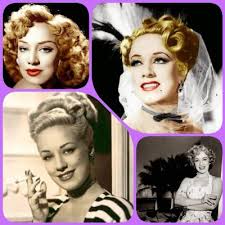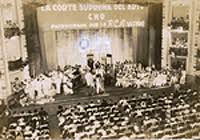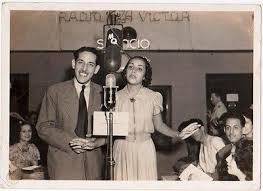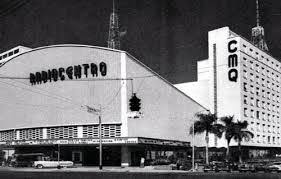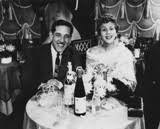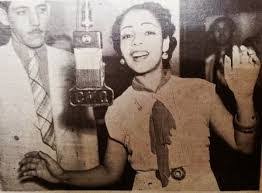 LA CORTE SUPREMA DEL ARTE, UN POPULAR Y POLEMICO PROGRAMA DE LA RADIO CUBANA.
LA CORTE SUPREMA DEL ARTE, UN POPULAR Y POLEMICO PROGRAMA DE LA RADIO CUBANA.
La Corte Suprema del Arte fue uno de los programas más populares y polémicos de la radio cubana entre los años 1930 a los 1950s. Surgió en momentos en que se necesitaba fortalecer y renovar el cuadro lírico en ese medio.
Es decir, lanzar al ruedo a nuevas figuras, las llamadas «estrellas nacientes», a fin de ir buscando relevo a los veteranos, que, por otra parte, devengaban honorarios altos.
Todos los que se presentaban en ese espacio eran aficionados, y el aplauso del público decidía cuál resultaba triunfador. No fue, en su momento, un acontecimiento del todo novedoso.
Antes, en un espacio que se llamó precisamente Programa de aficionados, que salía al aire por la radioemisora CMW, René Cañizares intentó un experimento muy parecido, cuando un jurado conformado por artistas profesionales seleccionaba las mejores actuaciones de aquellos que querían iniciarse en el mundo artístico.
Pero Programa de aficionados, copiado de un modelo norteamericano, no progresó por falta de iniciativas.
Cuando Miguel Gabriel y Ángel Cambó, propietarios entonces de la CMQ, quisieron darles mayor estructura a sus programas de música y de variedades, se encontraron con una dificultad: las pocas figuras líricas de las que disponían cobraban honorarios demasiado altos para la época y las posibilidades reales de la emisora.
Fue entonces que Gabriel y Cambó idearon la fórmula de dar entrada espectacular a todos los aficionados que pudieran convertirse en estrellas de la radio.
De ahí surgió la frase, que todavía se usa, de «le tocaron la campana», para indicar que alguien se ve imposibilitado de llegar a su meta porque otro se lo impide. Porque en La Corte Suprema del Arte se tocaba ciertamente la campana a aquel intérprete, cantante o recitador, que fuese notoriamente malo.
Esa campana —que desde la cabina de control y fuera de la vista del público y del mismo intérprete, hacía sonar Miguel Gabriel, uno de los propietarios de la CMQ de entonces— dio atractivo inicial al programa, que comenzó a salir al aire el 1ro. de diciembre de 1937, desde los estudios que esa emisora tenía en Monte, casi esquina a Cárdenas, en La Habana, y a los que se alude, de manera invariable y por comodidad, como ubicados en Monte y Prado.
Pronto los premios y los regalos que se llevaban los triunfadores atrajeron a una cantidad enorme de aspirantes. Y José Antonio Alonso, conocido hasta entonces como declamador y comentarista, lo consolidó con su conducción original.
Alonso tenía estilo propio y cultura, sabía improvisar y sus comentarios eran siempre atinados.
Hizo famosa una frase que marcaba el comienzo de la prueba. «¿A quién se lo va a dedicar?», preguntaba al aspirante.
Respondía este, y enseguida Alonso, dirigiéndose al director de la orquesta, añadía: «¡Música, maestro!».
Surgió así toda una pléyade de valores jóvenes lanzados por CMQ. Con su patrocinio, estaban en fiestas y ceremonias, no solo en la capital, también en ciudades del interior de la Isla, y muchos de ellos no demoraron en consolidarse y capitalizar las simpatías del público.
Todo el proceso de La Corte Suprema del Arte es polémico, afirma Oscar Luis López en su libro La radio en Cuba. Se inició contra el alto costo de los consagrados y derivó en un impulso potente de renovación.
Cayó más tarde en excesos, asevera el propio Oscar Luis, y hubo, mezclado con el triunfo legítimo de algunos buenos aficionados, malos manejos, explotación, intrigas y ciertas intimidades que dieron motivo a serias críticas.
Fue además expresión de la fiera competencia comercial que en esos años comenzaba a hacerse sentir en la radio. La Corte Suprema del Arte la patrocinó en sus inicios Competidora Gaditana, «el cigarro inigualable», tal como rezaba su eslogan.
Al obtener el programa un éxito sensacional, Miguel Gabriel, en una de sus jugadas de audacia, elevó de manera inusitada la cifra que debía pagar el anunciante, y obligó así a Competidora a dejar el campo libre a una empresa rival, la de los cigarros Regalías el Cuño, que previamente se había comprometido a abonar 12 000 pesos mensuales por el espacio.
Era una cifra descomunal en aquellos momentos, la que marcó el primer paso hacia los altos presupuestos de inversión en la radio.
Al margen de todo, sin embargo, La Corte Suprema del Arte reveló e impulsó a muchos valores perdurables.
Ahí están los nombres de Rosa Fornés, Raquel Revuelta, Elena Burke, Ramón Veloz, Obdulia Breijo, el dúo Hermanas Martí, Natalia Herrera y Armando Bianchi.
También están Alba Marina, Merceditas Valdés, Aurora Lincheta, Radeunda Lima, Xiomara Fernández, Anolan Díaz, la madre de Rubén Blades…, aunque se dice que allí a Benny Moré le tocaron la campana.
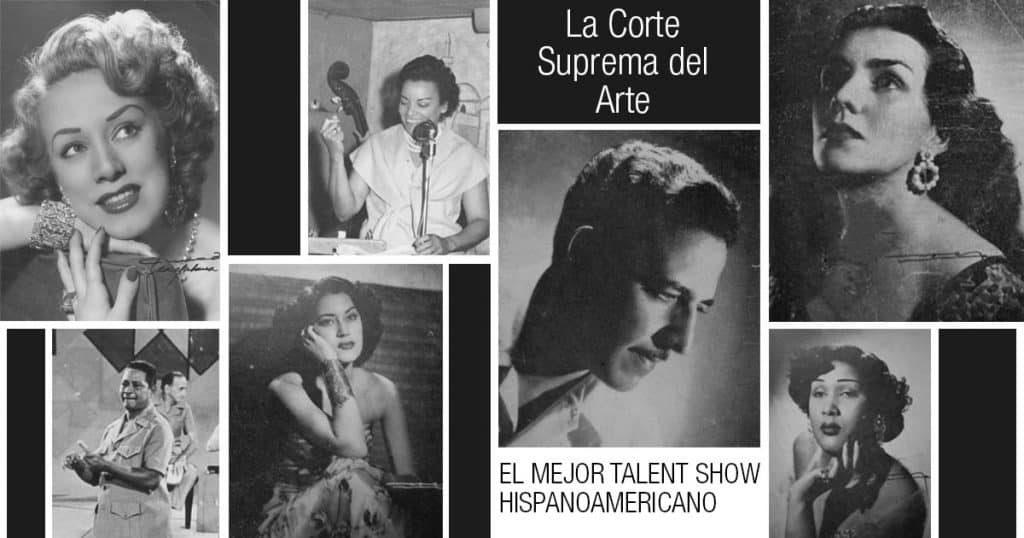 “THE SUPREME COURT OF ART”, A POPULAR AND POLEMIC PROGRAM OF THE CUBAN RADIO.
“THE SUPREME COURT OF ART”, A POPULAR AND POLEMIC PROGRAM OF THE CUBAN RADIO.
The Supreme Court of Art was one of the most popular and controversial programs on Cuban radio between the 1930s and 1950s de nuestra Cuba de entonces. It arose at a time when it was necessary to strengthen and renew the lyrical scene in that medium.
In other words, launch new figures, the so-called “rising stars”, in order to seek relief from veterans, who, on the other hand, earned high fees.
All those who appeared in that space were amateurs, and the applause of the public decided which was the winner. It was not, at the time, a completely new event.
Before, in a space that was precisely called the Amateur Program, which aired on the CMW radio station, René Cañizares tried a very similar experiment, when a jury made up of professional artists selected the best performances from those who wanted to start in the artistic world.
But the Amateur Program, copied from an American model, did not progress due to lack of initiatives.
When Miguel Gabriel and Ángel Cambó, owners of the CMQ at the time, wanted to give more structure to their music and variety programs, they encountered a difficulty: the few lyrical figures available to them charged fees too high for the time and the possibilities real of the station.
It was then that Gabriel and Cambó devised the formula to give spectacular entrance to all the fans who could become radio stars.
From there came the phrase, which is still used, of “they rang the bell”, to indicate that someone is unable to reach his goal because someone else is preventing him. Because in the Supreme Court of Art the bell was certainly ringing for that interpreter, singer or reciter, who was notoriously bad.
That bell – which was played by Miguel Gabriel, one of the owners of the CMQ at the time – from the control booth and out of view of the public and the same interpreter – gave initial appeal to the program, which began airing on the 1st. December 1937, from the studios, that this station had in Monte, almost on the corner of Cárdenas, in Havana, and to which it is alluded, invariably, and for convenience, as located in Monte and Prado.
Soon the winners’ prizes and gifts attracted huge numbers of applicants. And José Antonio Alonso, known until then as declaimer and commentator, consolidated it with his original leadership.
Alonso had his own style and culture, he knew how to improvise and his comments were always correct.
He made famous a phrase that marked the beginning of the test. “Who will you dedicate it to?” He asked the applicant.
The latter replied, and immediately Alonso, addressing the conductor of the orchestra, added: “Music, maestro!”
Thus emerged a whole pleiad of young values launched by CMQ. With their patronage, they were at parties and ceremonies, not only in the capital, but also in cities in the interior of the Island, and many of them did not take long to consolidate and capitalize on the sympathies of the public.
The entire process of the Supreme Art Court is controversial, says Oscar Luis López in his book La radio en Cuba. It started against the high cost of consecrated people and led to a powerful drive for renewal.
Later it fell into excesses, asserts Oscar Luis himself, and there was, mixed with the legitimate triumph of some good fans, mismanagement, exploitation, intrigue, and certain intimacies that gave rise to serious criticism.
It was also an expression of the fierce commercial competition that in those years began to make itself felt on the radio. The Supreme Art Court sponsored it in its early days, Competidora Gaditana, “the incomparable cigar”, as its slogan said.
When the program was a sensational success, Miguel Gabriel, in one of his audacious moves, raised in an unusual way the amount that the advertiser had to pay, and thus forced Competidora to leave the field open to a rival company, that of cigarettes Regalías el Cuño, which had previously agreed to pay 12,000 pesos per month for space.
It was a huge number at the time, the first step towards high investment budgets on the radio.
On the fringes of everything, however, the Supreme Court of Art revealed and propelled many enduring values.
There are the names of Rosa Fornés, Raquel Revuelta, Elena Burke, Ramón Veloz, Obdulia Breijo, the duo Hermanas Martí, Natalia Herrera and Armando Bianchi.
There are also Alba Marina, Merceditas Valdés, Aurora Lincheta, Radeunda Lima, Xiomara Fernández, Anolan Díaz, the mother of Rubén Blades …, although it is said that Benny Moré rang the bell there.
Agencies/ Wiki/ RHC/ Ciro Bianchi/ Extractos/ Excerpts/ Internet Photos/ YouTube/ Arnoldo Varona/ www.TheCubanHistory.com
THE CUBAN HISTORY, HOLLYWOOD.



